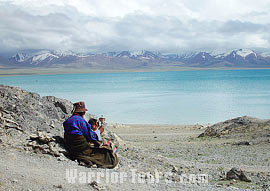Heavenly Lake Namtso

Located near Damxung County, Lake Namtso is one of the 'Three Holy Lakes' of Tibet. Covering an area of more than 1,920 square kilometers (about 474,442 acres), Namtso is the second largest saltwater lake in China. With an altitude of some 4,718 meters (15,475 ft) above sea level, the lake is also the highest saltwater lake in the world. The snow capped Mt. Nyainqentanglha, which Tibetans believe to be the husband of Lake Namtso, infuses into the lake melt-water of glaciers upon the mountain. Wild ducks and fish swim freely in the lake; grassland surrounding the lake provides a perfect home to black bear, yak, donkey, fox, deer and many other wild animals.
Namtso, meaning Heavenly Lake in Tibetan, is a holy destination for pilgrims. Since the year of the sheep on the Tibetan calendar is the year of The Buddha's, Bodhisattvas and Vajras assemble to hold religious ceremonies, many pilgrims will come to Namtso to walk or crawl around the lake. Five isles in the lake are sanctified as the avatars of Buddha's. Pilgrims can express their devoutness to the Buddha's by walking around the lake.
Note: The sea level of the Heavenly Lake Namtso is about 1,100 meters higher than that of Lhasa. It is suggested to bring some water and not to over-exert yourself.
How to Get to Heavenly Lake Namtso
No direct bus is available to Lake Namtso, so it is recommended to hire a taxi or private car from Lhasa.
| Admission Fee: | CNY120: May 1st to October 31st CNY60: November 1st to the next April 30th |
Lhasa has opened airlines to Beijing, Shanghai, Chongqing, Xian, Chengdu, Xining, Guangzhou, Kunming, and Katmandu. Gonggar Airport leads to the district by regular bus. The opening of Qinghai-Tibet Railway has made it possible to run between Lhasa and many other cities in China by train. In addition, there are five highways, Sichuan-Tibet Highway, Qinghai-Tibet Highway, Xinjiang-Tibet Highway, Yunnan-Tibet Highway and Sino-Nepal Highway, which link Lhasa and other places within and outside China.
There are many options for travel within Lhasa. Starting at Tibet Traditional Hospital, many scheduled buses and jeeps will stop when you wave them down. Taxis and pedicabs are also available in the city. Of course, you can also hire a car from a company or a bicycle at a hotel.
Lhasa covers an area of about 30 thousand square kilometers (7.4 million acres), about 3, 658 m (12 thousand ft) above the sea level on average. It has a plateau monsoon semi-arid climate. It is neither too hot in summer nor too cold in winter. The highest temperature is 29 ? (84 ?) while the lowest is -16.5 ? (2.3 ?). Rains fall mainly in July, August and September, and almost always during the night. It is sunny during the day almost all the year round. The sun shines on the city over 3,000 hours a year, hence the name 'City of Sunshine'.

